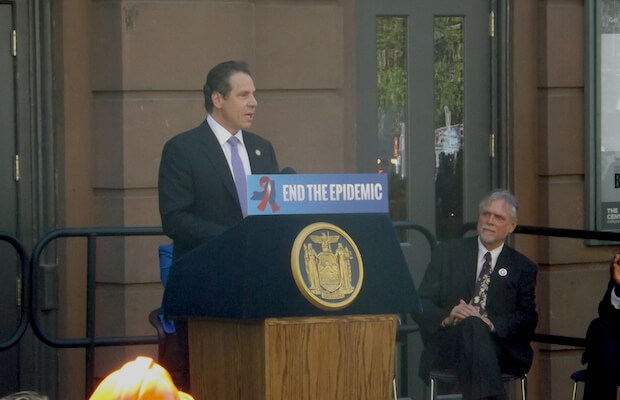With just three minutes on the mic at the 2016 Conference on Retroviruses and Opportunistic Infections (CROI), Sarit A. Golub, a psychologist with a master’s degree in public health, said, “I’m going to cut to the chase, since my title is a big spoiler.”
And with that, she launched into the data from SPARK, a collaborative project between the Callen-Lorde Community Health Center and Golub’s Hunter HIV/ AIDS Research Team, making the case that gave her talk its name: “STI Data From Community-Based PrEP Implementation Suggest Changes to CDC Guidelines.”
The desired change — seemingly justified not only by the Callen-Lorde data but also in findings from a broader PrEP demonstration project in other cities and other data at the conference on rising STI rates in gay men — is for the Centers for Disease Control and Prevention to recommend that all PrEP users have routine testing for sexually-transmitted diseases every three months, rather than waiting for six months or until a person reports symptoms as indicated in the current guidelines.
Researchers say HIV prevention drug not promoting infections; instead, identifying people most at risk
But, according to Golub and other researchers and providers of care, the findings are not an indictment. Instead, they reveal that PrEP is reaching those who may be at the most risk of HIV infection, while providing a structure for ongoing care that can help them be quickly diagnosed and treated for STDs.
“What this says to me,” she explained, “is that we are reaching the people who need PrEP. We are reaching people vulnerable to infection.”
In the project, 21 percent of people had experienced an STD within six months preceding their screening to initiate PrEP. Then, between 11 and 21 percent of participants were found to have an STD at each quarterly follow-up visit. The majority of STDs were anal gonorrhea or chlamydia, with lower rates of syphilis.
If the project had solely relied on screening for STDs only when participants reported symptoms, they would have missed 77 percent of STDs that were detected at the three-month visits and 69 percent of those detected at the nine-month visits.
Howard Grossman, MD, a gay doctor and PrEP user with a large medical practice in New York who said he is “beginning to get freaked out about the tidal wave of STDs I’m seeing in my practice,” also echoed the call for more frequent screenings. He explained that in 2014, he might see one new STI every week or two, but in the past nine months, he’s been seeing three or more infections in my patients nearly every day.”
Grossman noted that “some people have theorized that the STD increase is a statistical artifact caused by increased surveillance testing that we’re doing in our patients on PrEP. But I have been prescribing PrEP since 2013 and I can tell you that something very different is happening.”
Grossman said what he’s seeing does not support a causal link between PrEP use and STD incidence. Instead, he sees STI rates growing across the board and, like Golub, believes screenings undertaken by PrEP users can help address that epidemic.
He explained, “Others have blamed PrEP use for this, but this STD spike is not just happening in people on PrEP, who are actually leading the way in getting tested more frequently. I am also seeing the STD surge in patients who are not on PrEP, and in people who are HIV-positive and HIV-negative. Nor do I think it’s just that some have stopped using condoms. I am seeing spikes in oral infections as well as in anal ones, and no reasonable person has suggested condoms for oral sex for years.”
Grossman added, “The real problem, in my view, is that adequate screening and treatment for STDs is often not available. For the last 30 years, the only message about sexual health that many young people have gotten was either abstinence-only or, in more liberal venues, wear a condom every time to prevent HIV. The lack of knowledge about STDs, their transmission, prevention, and treatment is a damning indictment of our education system.”
In a PrEP-focused plenary at CROI 2016, Sheena McCormack, from the University College of London, who spoke on “Sexually Transmitted Infection Control in the Era of PrEP,” also gave the thumbs up for PrEP as a way of identifying and tackling STD risk, as part of a thorough presentation showcasing a range of new approaches to STD detection and treatment. Those approaches ranged from geospatial modeling to peer navigation of services to the use of private “self-swabbing” stations in stylish clinics where patients can submit samples via pneumatic tubes and await results via text message.
Using data across global PrEP studies, she concluded, “I hope I’ve convinced you that STIs were very high before PrEP and increasing… In this explosion of STIs that’s going on at the moment, there’s no need to see an explosion in HIV.”
In making her rapid-fire case for routine quarterly testing, Golub urged providers to get it right in PrEP programs from the start, saying, “It’s so incredibly important right now as we see tremendous increases in PrEP implementation across the country, as folks are starting to write their PrEP protocols, we need to get this message to them. Because you know it is a lot easier to have people start doing behavior correctly than to try to change it afterwards.”
JD Davids is the managing editor for TheBody.com and TheBodyPRO.com. Follow @JDAtTheBody on Twitter.


















